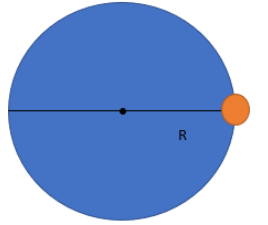Answer
352.2k+ views
Hint: Displacement is the shortest distance between two points and distance will be the actual distance. Displacement can be negative or positive according to the direction. But distance is always a positive quantity. The distance will always be equal or more than that of the displacement.
Complete step by step answer:
Distance is the actual path covered by the body and it is a scalar quantity, whereas the displacement is the shortest distance between the initial and final point. Displacement has magnitude and direction. Distance can’t be negative or zero.
If a particle moves in a circular path of radius R, half of the revolution implies the semi-circle.

So, the distance covered by the particle will be half of the circumference of the circle.
Circumference of a circle of radius R,
\[\Rightarrow 2\pi R\]
The distance covered by the particle will be,
\[\Rightarrow \dfrac{2\pi R}{2}=\pi R\]
Since the particle covered half revolution, the displacement of the particle will be the diameter of the circle. In this diagram, the particle is going to travel in the clockwise direction. The diameter is the maximum displacement that a body can make in a circular motion. So, the particle will be at exactly opposite to the initial position. The direction will depend upon the reference point that we are considering.
\[\vec{x}=2\vec{R}\], where the vector sign implies the direction of displacement.
Additional information:
Uniform circular motion can be two types. Uniform or non-uniform circular motion with respect to the speed.
Uniform circular motion is the motion of an object travelling at a constant speed on a circular path. The period is the time required to complete one cycle of revolution.
\[T=\dfrac{2\pi R}{v}\], where v is the velocity of rotation.
In a uniform circular motion, speed will be constant but the direction will be different at each point of the circle. Frequency is the number of revolutions completed by the particle in a unit time. In a uniform circular motion, the velocity is always tangent to the path of the object. This tangent specifies the direction of motion.
Note: Displacement and distance are different quantities even if they are using the same units. Displacement will be the shortest distance between the initial and final points. Displacement is a vector quantity. In the case of circular motion, we can calculate the distance by taking the circumference of that circle. The maximum displacement in a circular motion will be the diameter.
Complete step by step answer:
Distance is the actual path covered by the body and it is a scalar quantity, whereas the displacement is the shortest distance between the initial and final point. Displacement has magnitude and direction. Distance can’t be negative or zero.
If a particle moves in a circular path of radius R, half of the revolution implies the semi-circle.

So, the distance covered by the particle will be half of the circumference of the circle.
Circumference of a circle of radius R,
\[\Rightarrow 2\pi R\]
The distance covered by the particle will be,
\[\Rightarrow \dfrac{2\pi R}{2}=\pi R\]
Since the particle covered half revolution, the displacement of the particle will be the diameter of the circle. In this diagram, the particle is going to travel in the clockwise direction. The diameter is the maximum displacement that a body can make in a circular motion. So, the particle will be at exactly opposite to the initial position. The direction will depend upon the reference point that we are considering.
\[\vec{x}=2\vec{R}\], where the vector sign implies the direction of displacement.
Additional information:
Uniform circular motion can be two types. Uniform or non-uniform circular motion with respect to the speed.
Uniform circular motion is the motion of an object travelling at a constant speed on a circular path. The period is the time required to complete one cycle of revolution.
\[T=\dfrac{2\pi R}{v}\], where v is the velocity of rotation.
In a uniform circular motion, speed will be constant but the direction will be different at each point of the circle. Frequency is the number of revolutions completed by the particle in a unit time. In a uniform circular motion, the velocity is always tangent to the path of the object. This tangent specifies the direction of motion.
Note: Displacement and distance are different quantities even if they are using the same units. Displacement will be the shortest distance between the initial and final points. Displacement is a vector quantity. In the case of circular motion, we can calculate the distance by taking the circumference of that circle. The maximum displacement in a circular motion will be the diameter.
Recently Updated Pages
The deliquescent among the following is ACaCl2 BFeSO47H2O class 11 chemistry CBSE

The d electron configurations of Cr2 + Mn2 + Fe2 + class 11 chemistry CBSE

The degree of ionization of a 01M bromoacetic acid class 11 chemistry CBSE

The degree of Hydrolysis of CH3COONH4 is independent class 11 chemistry CBSE

The degree of hydrolysis for a salt of strong acid class 11 chemistry CBSE

The degree of hydrolysis for a salt of strong acid class 11 chemistry CBSE

Trending doubts
Which are the Top 10 Largest Countries of the World?

Difference Between Plant Cell and Animal Cell

Give 10 examples for herbs , shrubs , climbers , creepers

Fill the blanks with the suitable prepositions 1 The class 9 english CBSE

Write a letter to the principal requesting him to grant class 10 english CBSE

Difference between Prokaryotic cell and Eukaryotic class 11 biology CBSE

What is the full form of AD a After death b Anno domini class 6 social science CBSE

Change the following sentences into negative and interrogative class 10 english CBSE

Name 10 Living and Non living things class 9 biology CBSE



